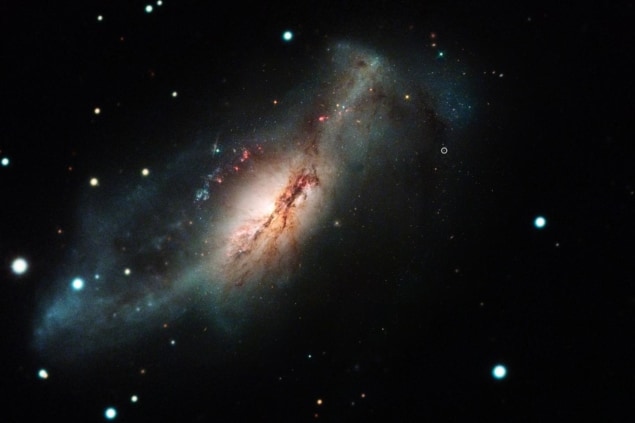
Astronomers have witnessed the very first example of a third type of supernova, first predicted theoretically over 40 years ago. The international team, led by Daichi Hiramatsu at Los Cumbres Observatory, California, confirmed their observation of an electron capture supernova by identifying six key features of the explosion and its progenitor star, first predicted by Japanese astronomer, Ken’ichi Nomoto.
So far, all supernovae identified by astronomers have fallen into two categories. For progenitor stars below roughly 8 solar masses, thermonuclear explosions occur as cores become hot enough to fuse helium into carbon and oxygen. At this point, stars dramatically expel most of their outer material, leaving behind a white dwarf. For stars heavier than around 10::solar masses, electron capture by neon and magnesium causes cores to collapse. Here atomic electrons can no longer withstand such immense gravitational pressures, causing matter in the core to rapidly compress into neutron stars or black holes – expelling vast amounts of energy in the process.
In 1980, Nomoto at the University of Tokyo first predicted that a third type of supernova must also be allowed, for progenitor stars falling between 8–10 solar masses. In his theory, core collapse is again initiated as electrons are captured by neon and magnesium – but this time, the core is gravitationally supported by the resulting thermonuclear explosion. This would leave behind a neutron star in equilibrium, neither expanding nor contracting.
Promising candidate
For 40 years after Nomoto’s initial proposal, uncertainties in his theoretical predictions of the signatures of such supernovae meant that no clear evidence for electron-capture supernovae was ever confirmed. Yet in March 2018, a promising candidate emerged in the galaxy NGC2146, roughly 31 million light–years away. Over the next two years, the subsequent rise and fall in brightness of the explosion was observed by a global network of telescopes. From archival images taken by both the Hubble and Spitzer Space Telescopes, Hiramatsu’s team also identified the most likely progenitor for the supernova.

Did a supernova trigger the late Devonian extinction?
Where previous observations had displayed a few of the indicators for electron-capture supernovae first predicted by Nomoto, Hiramatsu and colleagues identified all six of them for the first time. These were that the supernova’s progenitor star was on the super-asymptotic giant branch of main sequence stars; that it underwent strong mass loss prior to going supernova; it displayed spectral features which cannot be seen in either white dwarf or core collapse supernovae; it was a weak explosion, consistent with the properties of equilibrium; it emitted little radioactivity, and left behind a neutron-rich core.
By gathering clear evidence for all six factors, the team could finally confirm Nomoto’s predictions after over four decades. Their identification now provides new insights into stellar evolution, supernova physics, and the synthesis of heavy elements. It could also shed new light on the origin of the Crab Nebula, which first appeared in the sky in 1054. Similarities between the team’s results, and meticulous observations of Chinese astronomers at the time, now raise confidence that the famous nebula itself could have been created in an electron-capture supernova.
The observations are described in Nature Astronomy.
